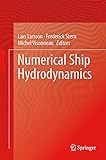Numerical Ship Hydrodynamics [electronic resource] : An assessment of the Gothenburg 2010 Workshop / edited by Lars Larsson, Frederick Stern, Michel Visonneau.
Contributor(s): Larsson, Lars [editor.] | Stern, Frederick [editor.] | Visonneau, Michel [editor.] | SpringerLink (Online service).
Material type: BookPublisher: Dordrecht : Springer Netherlands : Imprint: Springer, 2014Description: IX, 318 p. 170 illus., 20 illus. in color. online resource.Content type: text Media type: computer Carrier type: online resourceISBN: 9789400771895.Subject(s): Engineering | Computer mathematics | Fluid mechanics | Mechanical engineering | Engineering | Engineering Fluid Dynamics | Mechanical Engineering | Computational Science and EngineeringAdditional physical formats: Printed edition:: No titleDDC classification: 620.1064 Online resources: Click here to access online
BookPublisher: Dordrecht : Springer Netherlands : Imprint: Springer, 2014Description: IX, 318 p. 170 illus., 20 illus. in color. online resource.Content type: text Media type: computer Carrier type: online resourceISBN: 9789400771895.Subject(s): Engineering | Computer mathematics | Fluid mechanics | Mechanical engineering | Engineering | Engineering Fluid Dynamics | Mechanical Engineering | Computational Science and EngineeringAdditional physical formats: Printed edition:: No titleDDC classification: 620.1064 Online resources: Click here to access online 1 Introduction, Conclusions and Recommendations -- 2 Evaluation of Resistance, Sinkage and Trim, Self-Propulsion and Wave Pattern Predictions -- 3 Evaluation of Local Flow Predictions -- 4 Evaluation of Seakeeping Predictions -- 5 A Verification and Validation Study Based on Resistance -- 6 Additional Data for Resistance, Sinkage and Trim -- 7 Post Workshop Computations and Analysis for KVLCC2 and 5415.
This book assesses the state-of-the-art in computational fluid dynamics (CFD) applied to ship hydrodynamics and provides guidelines for the future developments in the field based on the Gothenburg 2010 Workshop. It presents ship hull test cases, experimental data and submitted computational methods, conditions, grids and results. Analysis is made of errors for global (resistance, sinkage and trim and self-propulsion) and local flow (wave elevations and mean velocities and turbulence) variables, including standard deviations for global variables and propeller modeling for self-propulsion. The effects of grid size and turbulence models are evaluated for both global and local flow variables. Detailed analysis is made of turbulence modeling capabilities for capturing local flow physics. Errors are also analyzed for head-wave seakeeping and forward speed diffraction, and calm-water forward speed-roll decay. Resistance submissions are used to evaluate the error and uncertainty by means of a systematic verification and validation (V&V) study along with statistical investigations. Post-workshop experimental and computational studies are conducted and analyzed for evaluation of facility biases and to draw more concrete conclusions regarding the most reliable turbulence model, appropriate numerical methods and grid resolution requirements, respectively.


There are no comments for this item.